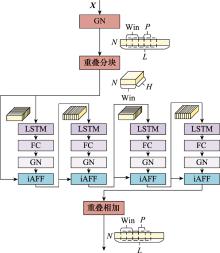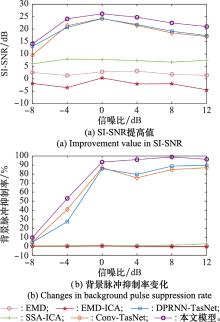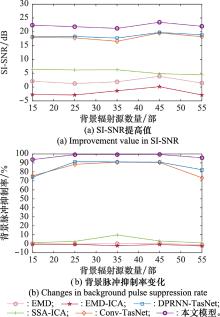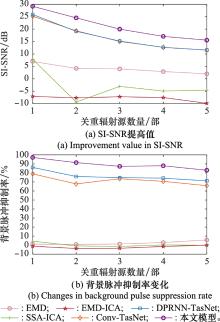Systems Engineering and Electronics ›› 2025, Vol. 47 ›› Issue (7): 2406-2413.doi: 10.12305/j.issn.1001-506X.2025.07.33
• Communications and Networks • Previous Articles
Background signal suppression algorithm based on dual-path feature fusion net
Wanying ZHANG1,2, Youbing GAO1,2, Zeyi LI1,2, Pengfei LI1,2, Wei ZHANG2,3,*
- 1. The 29th Research Institute of China Electronics Technology Group Corporation, Chengdu 610036, China
2. National Key Laboratory of Electromagnetic Space Security, Chengdu 610036, China
3. School of Information and Communication Engineering, University of Electronic Science and Technology of China, Chengdu 611731, China
-
Received:2024-06-26Online:2025-07-16Published:2025-07-22 -
Contact:Wei ZHANG
CLC Number:
Cite this article
Wanying ZHANG, Youbing GAO, Zeyi LI, Pengfei LI, Wei ZHANG. Background signal suppression algorithm based on dual-path feature fusion net[J]. Systems Engineering and Electronics, 2025, 47(7): 2406-2413.
share this article
| 1 | RIM J W , KOH I S . Survivability simulation of airborne platform with expendable active decoy countering RF missile[J]. IEEE Trans.on Aerospace and Electronic Systems, 2020, 56 (1): 197- 207. |
| 2 |
孙国敏, 张伟, 邵怀宗, 等. 基于低秩张量完备的电磁大数据标注补全算法[J]. 系统工程与电子技术, 2024, 46 (2): 381- 390.
doi: 10.12305/j.issn.1001-506X.2024.02.02 |
|
SUN G M , ZHANG W , SHAO H Z , et al. A low-rank tensor completion based method for electromagnetic big data annotation recovery[J]. Systems Engineering and Electronics, 2024, 46 (2): 381- 390.
doi: 10.12305/j.issn.1001-506X.2024.02.02 |
|
| 3 | WEI G H , LI M , ZHAO H Z . The general evaluation model for radio-frequency blocking effects of frequency equipment in complex electromagnetic environment[J]. IEEE Trans.on Antennas and Propagation, 2023, 71 (9): 7418- 7425. |
| 4 | CHEN T , YANG B Y , GUO L M . Radar pulse stream clustering based on MaskRCNN instance segmentation network[J]. IEEE Signal Processing Letters, 2023, 30 (1): 1022- 1026. |
| 5 | HASANI H , KHORAVI M R . Pulse deinterleaving based on fusing PDWs and PRI extraction process for radar-assisted edge devices considering computational costs[J]. EURASIP Journal on Wireless Communications and Networking, 2021, 2021, 98. |
| 6 | SU Y H , CHEN Z , GONG L F , et al. An improved adaptive radar signal sorting algorithm based on DBSCAN by a novel CVI[J]. IEEE Access, 2024, 12, 43139- 43154. |
| 7 | XIANG H R , SHEN F R , ZHAO J . Deep ToA mask-based recursive radar pulse deinterleaving[J]. IEEE Trans.on Aerospace and Electronic Systems, 2023, 59 (2): 989- 1006. |
| 8 | CHEN T, GUO W, SHEN B. A new radar emitter recognition method based on pulse sample figure[C]//Proc. of the 8th International Conference on Fuzzy Systems and Knowledge Discovery, 2011: 1902-1905. |
| 9 | ZHU R Q, WANG C Y, JIN S P, et al. Radar signal pre-sorting based on Mean- Shift algorithm[C]//Proc. of the 7th International Conference on Intelligent Computing and Signal Processing, 2022: 1766-1769. |
| 10 | LI X Q , LIU Z M , HUANG Z T . Deinterleaving of pulse streams with denoising autoencoders[J]. IEEE Trans.on Aerospace and Electronic Systems, 2020, 56 (6): 4767- 4778. |
| 11 | GUO R H , DONG Y Y , ZHANG L D , et al. Radar reconnaissance pulse-splitting modeling and detection method[J]. Remote Sensing, 2024, 16 (3): 521. |
| 12 |
高霞, 全英汇, 李亚超, 等. 基于BSS的FDA-MIMO雷达主瓣欺骗式干扰抑制方法[J]. 系统工程与电子技术, 2020, 42 (9): 1927- 1934.
doi: 10.3969/j.issn.1001-506X.2020.09.07 |
|
GAO X , QUAN Y H , LI Y C , et al. Main-lobe deceptive jamming suppression with FDA-MIMO radar based on BSS[J]. Systems Engineering and Electronics, 2020, 42 (9): 1927- 1934.
doi: 10.3969/j.issn.1001-506X.2020.09.07 |
|
| 13 | CHEN S , LIN Y , YUAN Y , et al. Suppressive interference suppression for airborne SAR using BSS for singular value and eigenvalue decomposition based on information entropy[J]. IEEE Trans.on Geoscience and Remote Sensing, 2023, 61, 5205611. |
| 14 | ZHANG H L , ZHANG G , XUE B , et al. Mainlobe jamming suppression via improved BSS method for rotated array radar[J]. Journal of Systems Engineering and Electronics, 2022, 33 (6): 1151- 1158. |
| 15 | DAVIES M E , JAMES C J . Source separation using single channel ICA[J]. Signal Processing, 2007, 87 (8): 1819- 1832. |
| 16 | KOPSINIS Y , MCLAUGHLIN S . Development of EMD-based denoising methods inspired by wavelet thresholding[J]. IEEE Trans.on Signal Processing, 2009, 57 (4): 1351- 1362. |
| 17 | MOSTAFA M H , CHAMAANI S , SACHS J . Singular spectrum analysis-based algorithm for vitality monitoring using M-sequence UWB sensor[J]. IEEE Sensors Journal, 2020, 20 (9): 4787- 4802. |
| 18 | 张伟, 王沙飞, 林静然, 等. 基于孪生网络的电磁目标跨模式识别算法[J]. 电子学报, 2022, 50 (6): 1281- 1290. |
| ZHANG W , WANG S F , LIN J R , et al. Cross-modal recognition algorithm of electromagnetic targets via siamese network[J]. Acta Electronica Sinica, 2022, 50 (6): 1281- 1290. | |
| 19 | 曾令华, 高由兵, 梁超, 等. 基于深度学习的同型雷达的脉冲中频信号分离技术[J]. 电子信息对抗技术, 2023, 38 (6): 53- 60. |
| ZENG L H , GAO Y B , LIANG C , et al. Intermediate frequency pulse signal separation technology of homogeneous radar based on deep learning[J]. Electronic Information Warfare Technology, 2023, 38 (6): 53- 60. | |
| 20 | HE Y H, SANG X, LI Y G. A radarsignal sorting algorithm based on improved FastICA[C]//Proc. of the IEEE 3rd International Conference on Information Technology, Big Data and Artificial Intelligence, 2023: 1625-1628. |
| 21 | LIU S , WANG B M , ZHANG L Y . A method for blind source separation of multichannel electromagnetic radiation in the field[J]. IEEE Access, 2020, 8, 191341- 191354. |
| 22 | WU Z W , YUAN D , ZHANG F G , et al. Improving accuracy of low-cost vehicle attitude estimation by de-noising MIMU based on SSA and ICA[J]. IEEE Trans.on Instrumentation and Measurement, 2021, 70, 9507213. |
| 23 | DUTT R, MONDAL S, ACHARYYA A. Single channel blind source separation using dual extended kalman filter[C]//Proc. of the IEEE International Symposium on Circuits and Systems, 2021. |
| 24 | LUO Y, MESGARANI N. TasNet: time-domain audio separation network for real-time, single-channel speech separation[C]//Proc. of the IEEE International Conference on Acoustics, Speech and Signal Processing Single-Channel Speech Separation, 2018: 696-700. |
| 25 | LUO Y , MESGARANI N . Conv-TasNet: surpassing ideal time-frequency magnitude masking for speech separation[J]. IEEE/ACM Trans.on Audio, Speech, and Language Processing, 2019, 27 (8): 1256- 1266. |
| 26 | LUO Y, CHEN Z, YOSHIOKA T. Dual-path RNN: efficient long sequence modeling for time-domain single-channel speech separation[C]//Proc. of the ICASSP 2020-2020 IEEE International Conference on Acoustics, Speech and Signal Processing, 2020: 46-50. |
| 27 | DAI Y M, GIESEKE F, OEHMCKE S, et al. Attentional feature fusion[C]//Proc. of the IEEE Winter Conference on Applications of Computer Vision, 2021: 3559-3568. |
| 28 | LI A D , YU G C , ZHENG C S , et al. A general unfolding speech enhancement method motivated by Taylor's theorem[J]. IEEE/ACM Trans.on Audio, Speech, and Language Processing, 2023, 31, 3629- 3646. |
| 29 | ZHANG Z W , ZHU M T , LI Y J , et al. JDMR-Net: joint detection and modulation recognition networks for LPI radar signals[J]. IEEE Trans.on Aerospace and Electronic Systems, 2023, 59 (6): 7575- 7589. |
| 30 | CUI G L , LI H B , MURALIDHAR R , et al. MIMO radar waveform design with constant modulus and similarity constraints[J]. IEEE Trans.on Signal Processing, 2014, 62 (2): 343- 353. |
| 31 | FENG H C , TANG B , WAN T . Radar pulse repetition interval modulation recognition with combined net and domain-adaptive few-shot learning[J]. Digital Signal Processing, 2022, 127, 103562. |
| [1] | Xinzheng ZHANG, Mengke YAN, Xiaolin ZHU. Noise pseudo-label tolerant semi-supervised SAR target recognition [J]. Systems Engineering and Electronics, 2025, 47(6): 1796-1805. |
| [2] | Zhijie JIANG, Heng SONG, Nan HU, Lanxi DUAN, Ping CAO. Target recognition and classification algorithm of MMW radar in tunnel [J]. Systems Engineering and Electronics, 2025, 47(5): 1453-1460. |
| [3] | Qianqi NIE, Minghui SHA, Yingshen ZHU, Chongyu WANG, Nianqiang CUI. Radar multi-component signal recognition method based on blind source separation combined with singular spectrum analysis [J]. Systems Engineering and Electronics, 2025, 47(4): 1168-1175. |
| [4] | Lei YUAN, Yanjuan YANG, Yi GUO, Peng DAI. Deep learning-based semi-blind identification algorithm for code rates of LDPC codes with correlated noise [J]. Systems Engineering and Electronics, 2025, 47(4): 1335-1345. |
| [5] | Xiarun SHEN, Ruonan LI, Haotian ZHANG. Server KPI anomaly detection based on CVAE-LSTM [J]. Systems Engineering and Electronics, 2025, 47(3): 1019-1027. |
| [6] | Xiaolin LIU, Mengjiao GUO, Zhuo LI. Adaptive graph convolutional recurrent network prediction method for flight delay based on Dueling DQN optimization [J]. Systems Engineering and Electronics, 2025, 47(2): 568-579. |
| [7] | Weihong FU, Xinyu ZHANG, Naian LIU. Single-channel blind source separation algorithm for co-frequency and co-modulation based on multi-scale fusion neural network [J]. Systems Engineering and Electronics, 2025, 47(2): 641-649. |
| [8] | Wei CAI, Xin WANG, Xinhao JIANG, Zhiyong YANG, Dong CHEN. Research on few shot target detection method based on decoupling [J]. Systems Engineering and Electronics, 2024, 46(9): 2941-2950. |
| [9] | Xiaoxuan CHEN, Shuwen XU, Shaohai HU, Xiaole MA. Infrared and visible light image fusion based on convolution and self attention [J]. Systems Engineering and Electronics, 2024, 46(8): 2641-2649. |
| [10] | Keyu CHEN, Jian YANG, Wei ZHANG, Guomin SUN, Huaizong SHAO. Maximum likelihood estimation based deinterleaving algorithm of radar signal in non-ideal scenarios [J]. Systems Engineering and Electronics, 2024, 46(7): 2276-2284. |
| [11] | Qianglong WANG, Xiaoguang GAO, Bicong WU, Zijian HU, Kaifang WAN. Review of research on restricted Boltzmann machine and its variants [J]. Systems Engineering and Electronics, 2024, 46(7): 2323-2345. |
| [12] | Xiantao SUN, Wangyang JIANG, Wenjie CHEN, Weihai CHEN, Yali ZHI. Object grasp pose detection based on the region of interest [J]. Systems Engineering and Electronics, 2024, 46(6): 1867-1877. |
| [13] | Xuemei CHEN, Zhiheng LIU, Suiping ZHOU, Hang YU, Yanming LIU. Road extraction from high-resolution remote sensing images based on HRNet [J]. Systems Engineering and Electronics, 2024, 46(4): 1167-1173. |
| [14] | Tianwen ZHANG, Xiaoling ZHANG, Zikang SHAO, Tianjiao ZENG. Mask attention interaction for SAR ship instance segmentation [J]. Systems Engineering and Electronics, 2024, 46(3): 831-838. |
| [15] | Junyang GONG, Weihong FU, Naian LIU. Design of SAR image target contour enhancement preprocessing module [J]. Systems Engineering and Electronics, 2024, 46(12): 4010-4017. |
| Viewed | ||||||
|
Full text |
|
|||||
|
Abstract |
|
|||||











